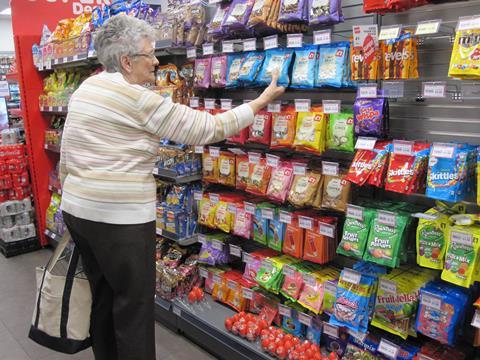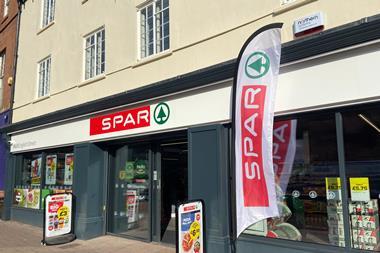
Business and retail groups have put forward 25 questions that must be answered ahead of the implementation of regulations surrounding High Fat, Salt & Sugar (HFSS) in October 2022.
Ahead of a Parliamentary session in which MPs will outline the specifics of the legislation, the Association of Convenience Stores (ACS), the British Retail Consortium (BRC) and the Food and Drink Federation (FDF) have submitted a list of questions that relate to their members.
These include:
- Do seating areas count towards relevant floor space calculations?
- What constitutes a ‘meal deal’ and ‘relevant special offers’ that are exempt (e.g. ‘Big Night In’, BBQ/gift bundles)?
- Can non-food and specified foods be promoted together, for example a newspaper and a drink for £x or newspaper and a chocolate bar for £x?
- What is the definition of a ‘customer route through store’ and how does this affect inclusion of end of aisles? What would be exempt (e.g. islands, and how are these defined)?
The full list of 25 unanswered questions on the HFSS regulations is available here.
One of the main areas of confusion surrounds the future of meal deals and ‘big night in’ promotions. The groups argue that in the current draft of the regulations, this type of promotion is set to be excluded from the regulations, but there’s no definition of what a meal deal actually is, that could lead to confusion for shoppers and chaos for retailers.
The ACS estimates that small shops face a £13,000 bill to comply with the regulations, while larger stores face costs of up to £100,000 to rethink their store layouts and warned that with so many unanswered questions these costs could spiral further as we move closer to the implementation date.
Chief executive of the ACS James Lowman said: “We are committed to working with the Government to ensure that retailers comply with the new regulations when they come into force, but the clock is ticking toward the implementation date and we’re no closer to having a clear set of regulations and guidance that retailers can follow. These regulations will force retailers into making huge changes to the way that their stores are laid out, as well as almost starting from scratch on the offers that they can provide to customers. With so many unanswered questions, the only sensible option is to delay the introduction of the rules to at least Spring 2023 to allow everyone to prepare.”
Chief scientific officer at the Food and Drink Federation Kate Halliwell said: “Food and drink manufacturers are working hard to review their portfolios to determine what can or cannot be promoted under the new rules. But with a lack of guidance for industry, there is still much uncertainty around exactly which products will be impacted. The Government also urgently needs to update its technical guidance which helps companies calculate if their products are ‘HFSS’ and subject to regulations. Without these key pieces of guidance, companies are struggling to prepare with only 11 months till the new rules come into force.”
Director of food and sustainability at the British Retail Consortium Andrew Opie said: “Retailers are fully committed to working constructively with government to tackle obesity and help consumers lead healthier lifestyles. They have led the way, reformulating own-brand products, promoting healthier options and working with local communities to highlight the benefits of eating well. However, with less than 12 months to go until the new regulations come into force, retailers are still waiting for clarity on the detail of the regulations and accompanying guidance. Without this, they cannot start to carry out the required work to bring stores and websites to compliance, which will involve making major changes to the way stores are laid out and the promotions they can offer customers. The government has already acknowledged that businesses need at least 12 months to prepare and moving the implementation date to Spring 2023 would give an appropriate timeframe for retailers to work towards.”
HFSS Promotional Restrictions: Top 25 unanswered questions
BUSINESSES IN SCOPE
1. What is the definition of a specialist retailer? Many common examples (e.g. chocolatier, cake shop, off license) sell products from more than one category so the current definition is not appropriate.
2. When determining size of business, should the number of employees include those registered within England, UK or globally? Please provide a specific legal reference on how this is defined.
3. What is the definition of ‘food for immediate consumption’ included in the definition of restaurants? This must align with the out of home calorie labelling Regulations.
4. DHSC has explained that ‘a premise that mainly sells or produces food for immediate consumption’ in the definition of restaurant relates to the business function. How can we legally justify the exclusion of supermarket cafes from the scope of the Regulation?
ONLINE PROMOTIONS
5. The Regulation applies in England. Do the rules apply to businesses registered in England only? Or to business selling food and delivering in England? If the latter is the case, how will this be enforced?
6. How do the online promotion rules interplay with the new online advertising rules and existing CAP codes?
7. In what capacity and how will retailers be expected to work with third party delivery platforms to assess the product category and NPM score of each product sold?
8. Customers can opt into being delivered a substitute if their chosen product is not available. Why can the customer not be offered a substitute on the website, when one of their favourite products is not available?
VOLUME PRICE PROMOTIONS
9. Please can you share further principles and examples of what constitutes a ‘meal deal’ and ‘relevant special offers’ that are exempt (e.g. ‘Big Night In’, BBQ/gift bundles)?
10. Can non-food and specified foods be promoted together, for example a newspaper and a drink for £x or newspaper and a chocolate bar for £x?
11. Will retailers have an additional sell through period for products with on pack promotions past October 2023?
PRODUCTS AND CATEGORIES IN SCOPE
12. How should products be categorised that contain elements from different schedule 1 categories e.g. granola and yoghurt pots or chocolate covered savoury snacks? Is this based on the category that the largest proportion of the product falls into?
13. There are many references to packaging format (e.g. bagged snacks, roll pack, bar shaped etc.) but this does not cover all format options. Clarification is needed on whether non-specified product formats are in or out of scope?
14. When will the Nutrient Profile Model Technical Guidance be updated and published so that companies can accurately calculate the NPM scores? Will a standardised online calculator be shared?
15. What are the practical criteria and principles to determine which products are in or out of scope for each category? E.g. what criteria determines whether a product is considered a starter/side/small plate (out of scope) rather than a meal centre/ready meal/breaded or battered product (in scope)?
*An extensive list of product specific questions has also been submitted.
LOCATIONS IN STORE
16. Do seating areas count towards relevant floor space calculations?
17. What is the definition of ‘covered external areas’ in regard to store entrances and the entrance space calculation? For example, considering petrol forecourts.
18. Are HFSS products allowed to be displayed where a premise has a dedicated exit?
19. What does ‘set aside and marked’ relate to? All floor markings? What about promotional bins that do not mark out queuing areas?
20. What is the definition of an aisle for purpose of in aisle exemption within 2m of a designated queuing area and within 2m of a checkout facility?
21. What is the definition of a ‘customer route through store’ and how does this affect inclusion of end of aisles? What would be exempt (e.g. islands, and how are these defined)?
22. How are concessions being determined? Under Example 2 in the guidance, it makes no reference to their own payment facilities. What is the definition of ‘primary responsibility’ of a concession in store?
23. Why are aisles covered in the semicircle defining store entrance included, even when they cannot be seen when the customer walks into store?
LIABILITY AND ENFORCEMENT
24. Where does liability sit for products on online delivery platforms? Retailers will not be able to control where a product is placed or promoted on the platform.
25. Who is to lead on enforcing this Regulation - Trading Standards, Environmental Health Officers or both?
(Source: ACS, BRC & FDF)




























1 Readers' comment